Authentic Polish Golumpki (Stuffed Cabbage)
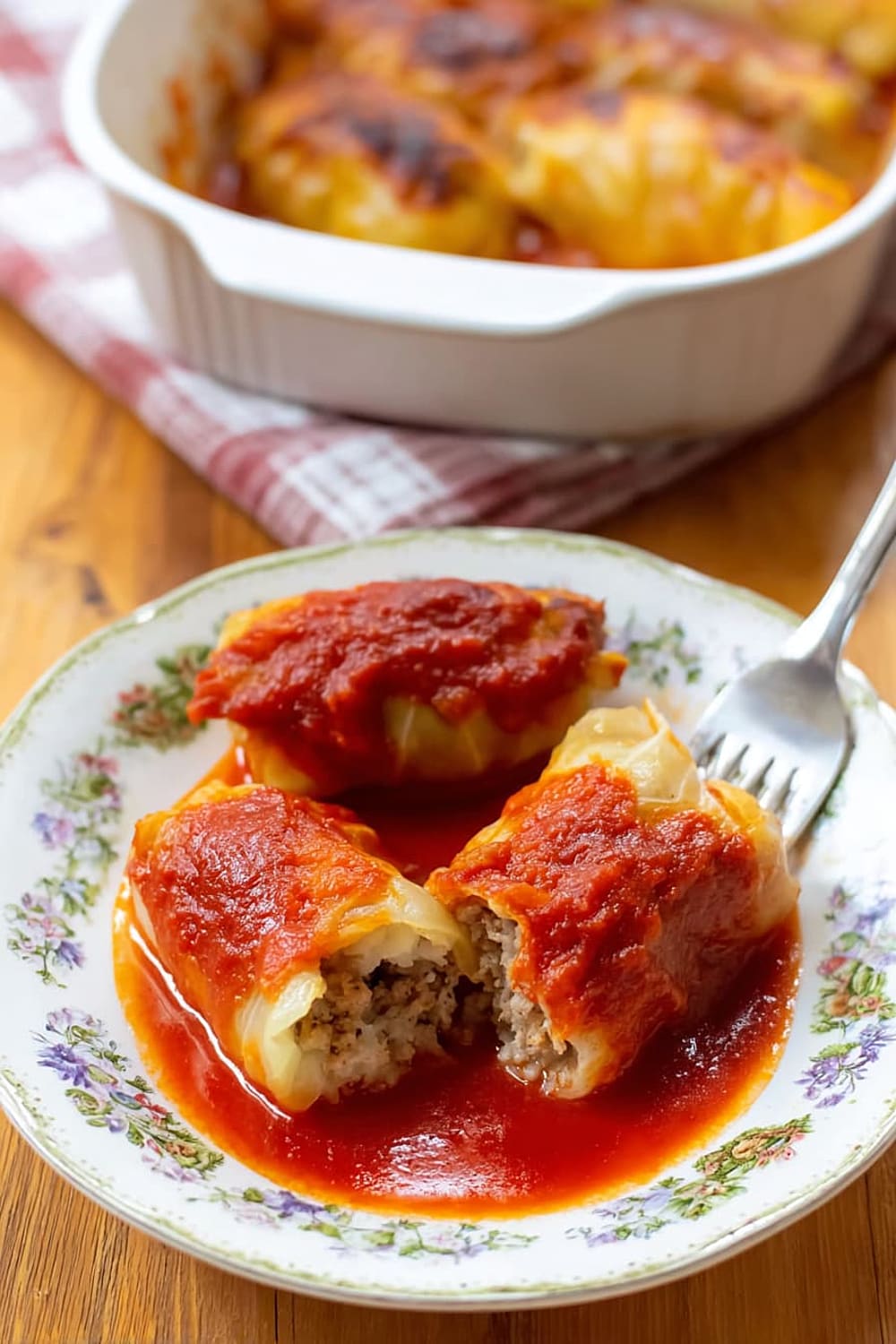
These adorable little cabbage bundles are basically edible hugs filled with the most comforting meat and rice mixture you’ll ever taste.

Picture tender cabbage leaves wrapped around a savory filling that’s been perfected by Polish grandmothers for generations, then smothered in a rich tomato sauce that makes everything better.
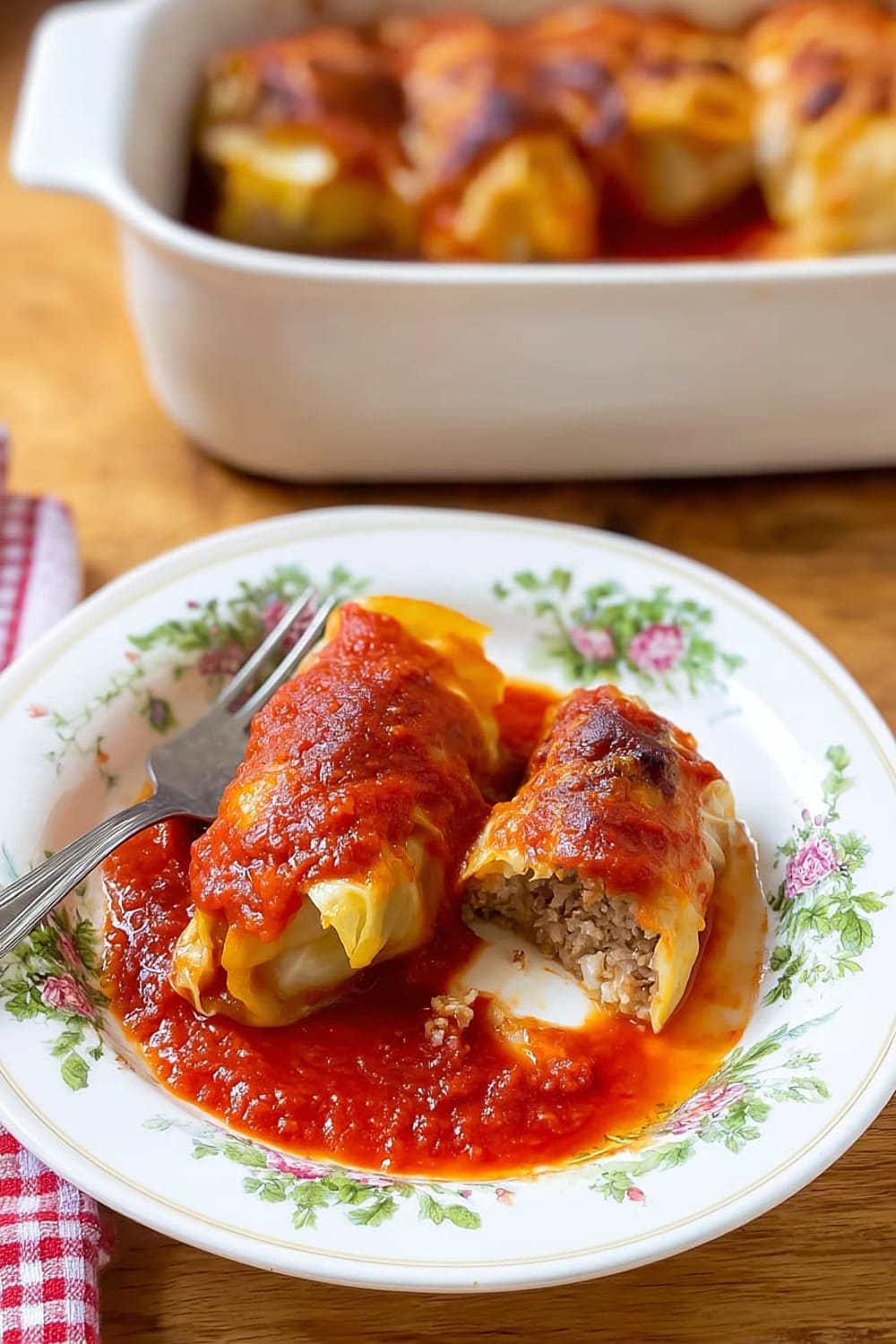
This recipe transforms humble ingredients into something that looks fancy enough for company but tastes like pure comfort food nostalgia.
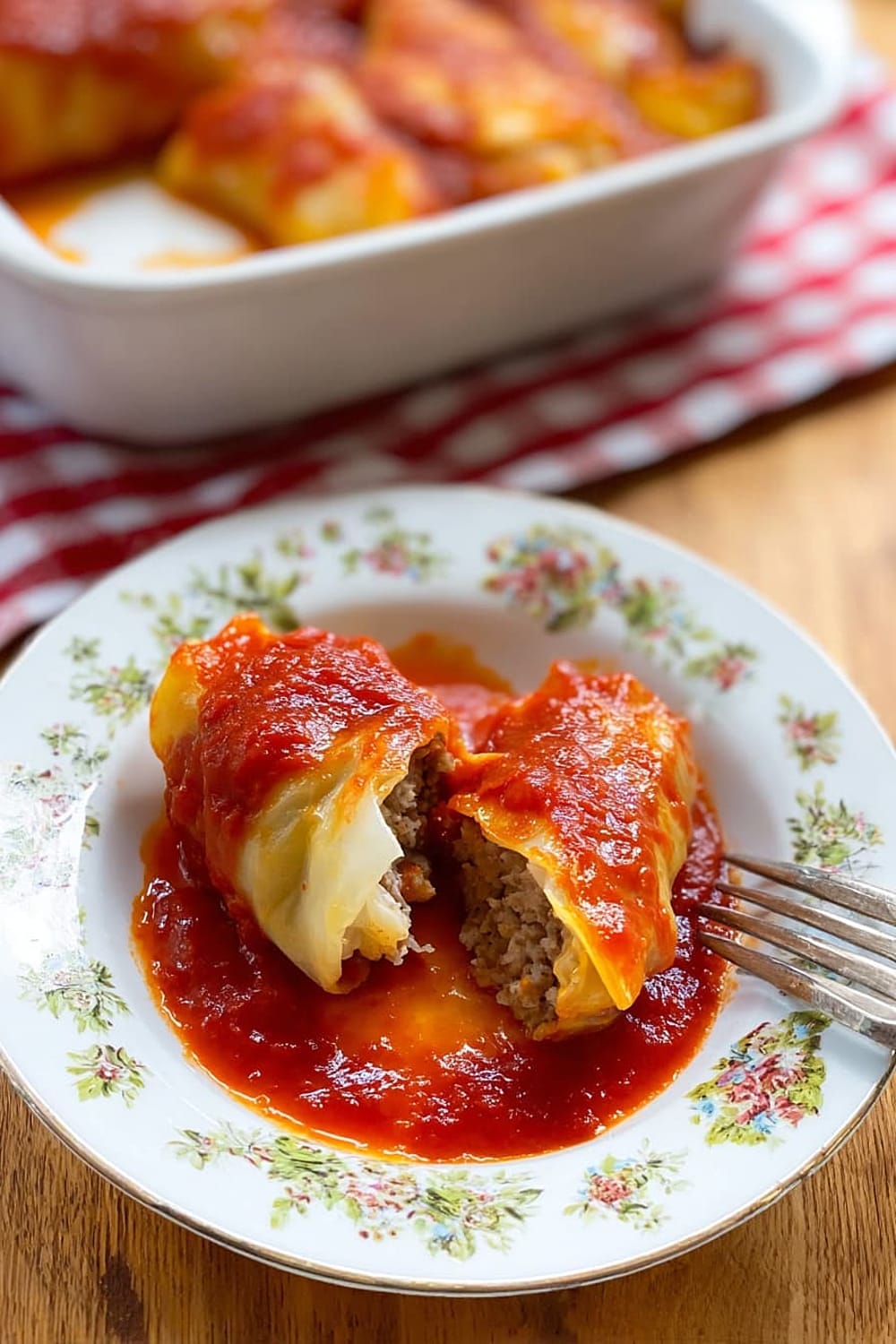
The best part is watching people’s faces when they bite into these perfectly seasoned parcels and realize you actually made something this impressive from scratch.
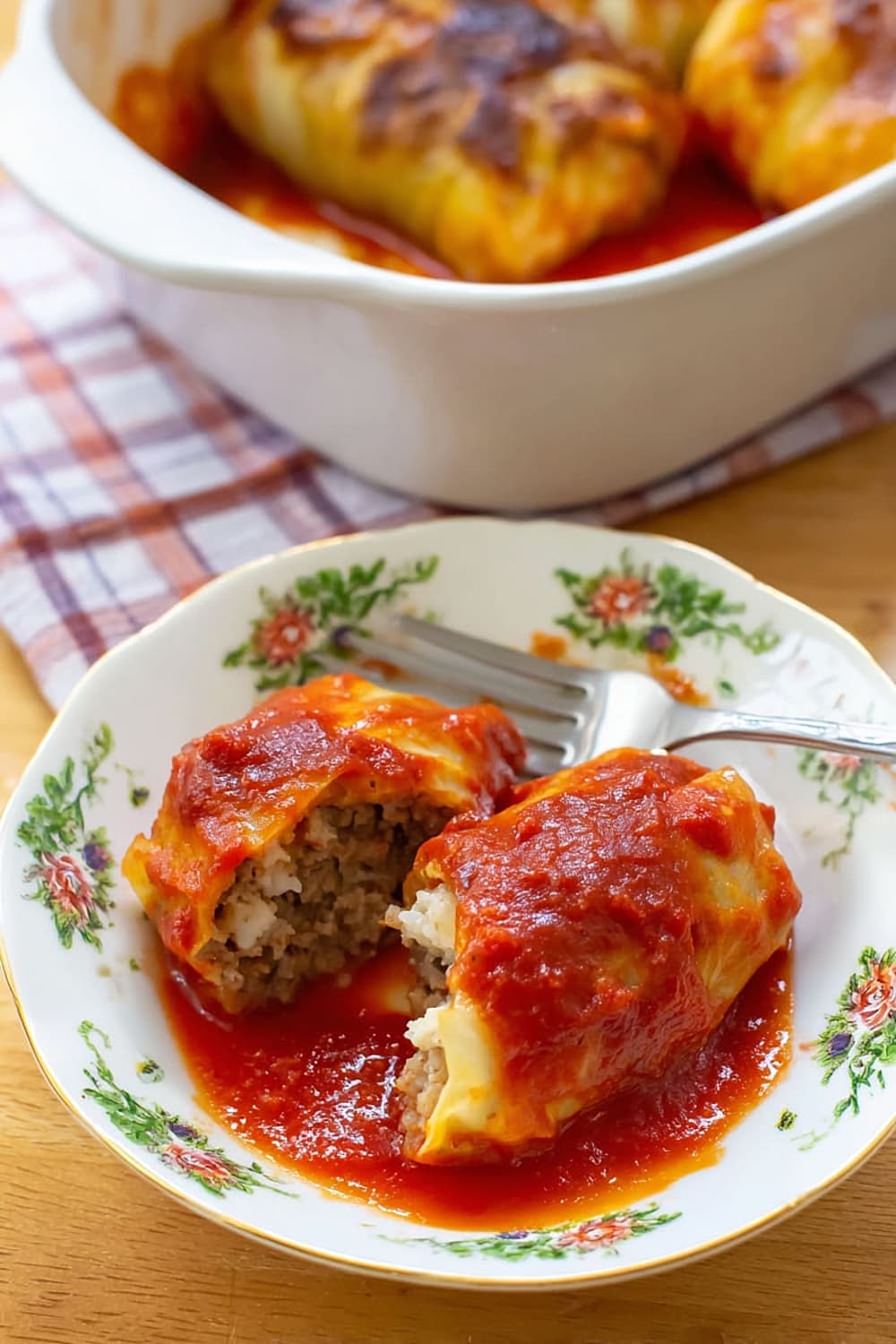
Each roll delivers that perfect balance of textures – silky cabbage, hearty filling, and a sauce so good you’ll want to drink it straight from the pot.
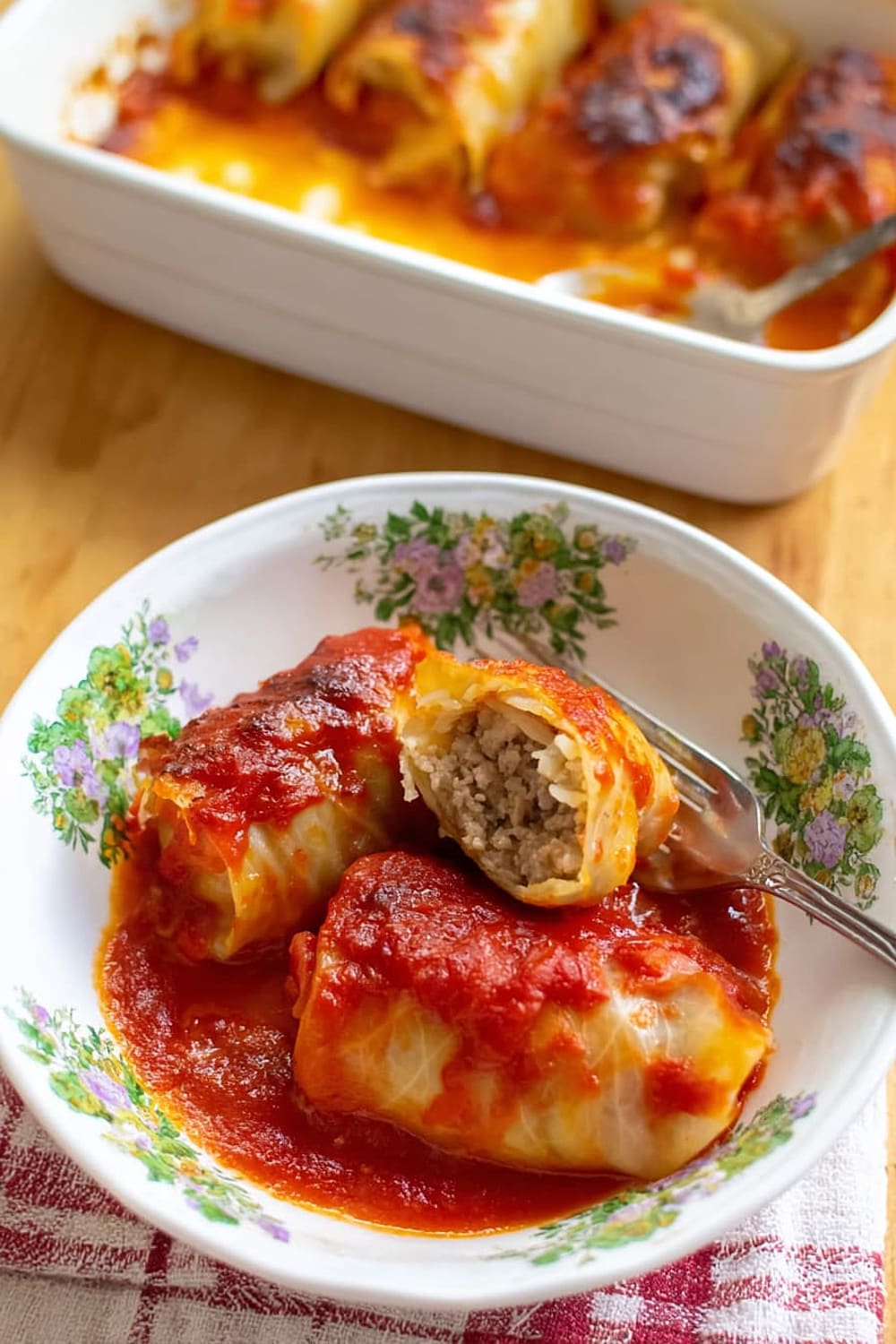
Fair warning: making these will officially promote you to “the one who can actually cook” status in your friend group, so prepare for recipe requests.
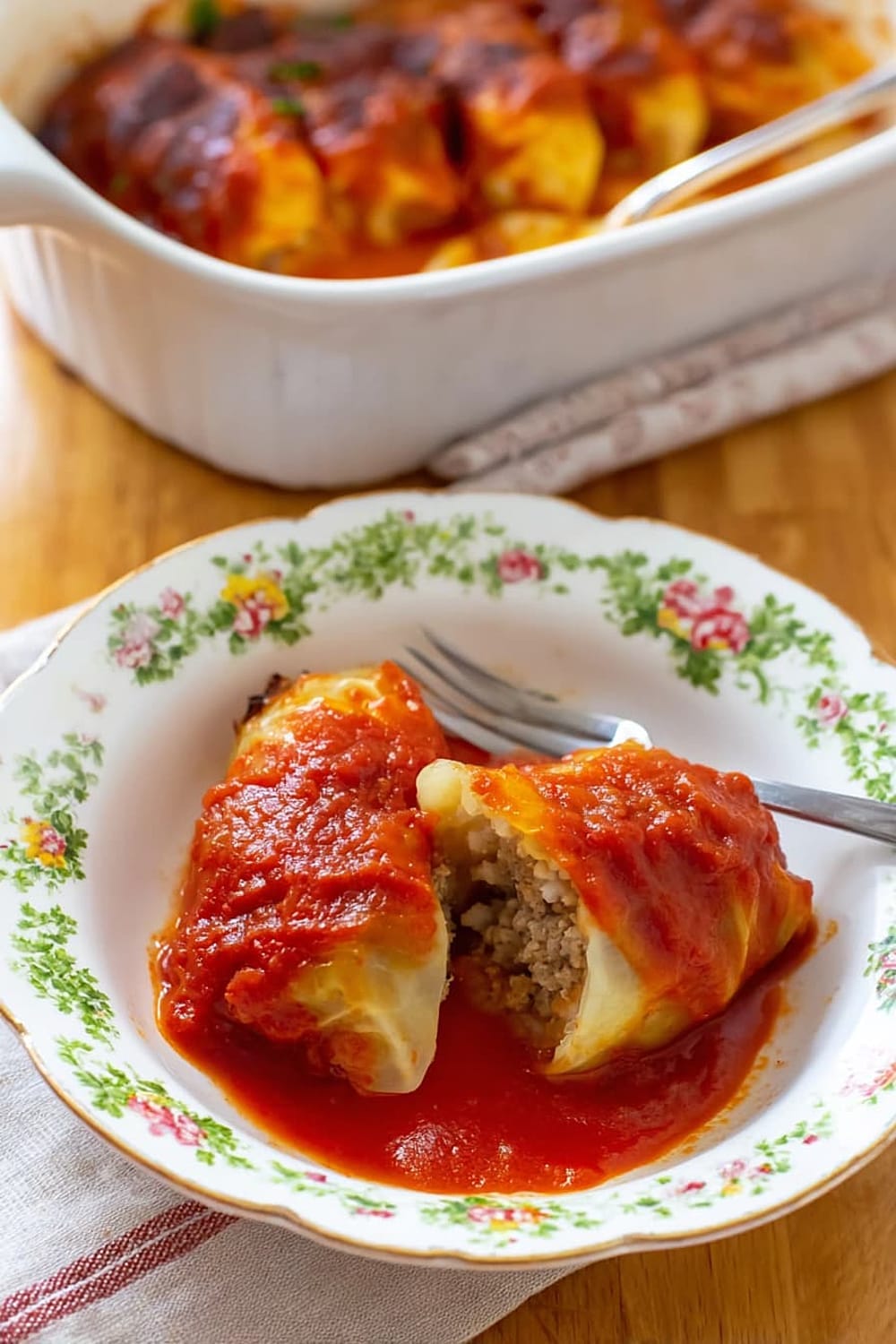
Ingredients
For the Filling
- 1 large cabbage (green or white)
- 250 grams ground veal (or substitute with ground beef)
- 250 grams ground pork
- 500 grams cooked rice (about 2½ cups cooked)
- 1 large onion, diced
- 0 .6 liters beef stock (about 2½ cups)
- 1 tablespoon salt, plus extra for cabbage water
- ½ teaspoon black pepper
- 1½ tablespoons fresh rosemary, chopped
- 2 tablespoons butter
For the Tomato Sauce
- 0 .7 liters passata (tomato purée, about 3 cups)
- 70 grams tomato paste (3 heaped tablespoons)
- 0 .4 liters beef stock (about 1⅔ cups)
- 2 garlic cloves, minced
- 8 allspice berries
- 8 black peppercorns
- ½ teaspoon salt
- 2 bay leaves
- 2 tablespoons butter
Instructions
Preparation Phase
- 1 Cook your rice using your preferred method, but reduce the cooking time by half – you want it tender but not fully cooked since it will finish cooking in the oven. While the rice cooks, use a sharp knife to mince your 1 large onion and finely chop the 1½ tablespoons fresh rosemary.
- 2 Heat a large skillet over medium-low heat and add the diced onion along with ½ teaspoon salt. Let the onions sweat for about 5 minutes, stirring occasionally until they become translucent and fragrant. Add the chopped rosemary and cook for an additional 3 minutes until aromatic, then remove from heat and set aside.
- 3 Prepare your cabbage by carefully removing the core – this is crucial for the leaves to separate properly during cooking. Using a sharp paring knife, cut around the core in a cone shape, going deep enough that the leaves will easily detach when cooked. If you don’t cut deep enough, the leaves won’t separate properly.
Cabbage Blanching
- 4 Place the cored cabbage core-side down in a large pot and cover completely with water. Add approximately 2 tablespoons salt to the water – this heavily salted water will help season the leaves and maintain their bright color. Bring to a rolling boil over high heat.
- 5 Watch carefully as the outer leaves begin to soften and naturally separate from the cabbage head. Using a pair of tongs, gently remove each leaf as it becomes pliable and starts to detach – this usually takes 20-30 minutes total. The leaves should be blanched and flexible but not overcooked, as overcooked leaves tear easily during rolling.
- 6 Continue this process until all usable leaves have been removed. Don’t worry if some leaves get small holes – you can use these to line your baking dish. Set the blanched leaves aside on a clean kitchen towel to cool and drain.
Assembly Phase
- 7 In a large mixing bowl, combine the ground veal, ground pork, partially cooked rice, sautéed onion mixture, remaining salt, and black pepper. Using clean hands, mix everything together until well combined – the mixture should hold together when squeezed but not be overly compact.
- 8 Preheat your oven to 180°C (350°F). Line the bottom of a large rectangular baking dish with any torn or smaller cabbage leaves – this prevents the rolls from sticking and adds extra flavor.
- 9 Working with one cabbage leaf at a time, choose leaves that are intact and large enough to wrap. Using a sharp knife, carefully trim away part of the thick central vein to make rolling easier. Place 1½ to 2½ tablespoons of filling (depending on leaf size) near the bottom edge of the leaf.
- 10 Roll each cabbage leaf by first folding the bottom edge over the filling, then folding in the sides, and finally rolling tightly toward the top of the leaf. Place each completed roll seam-side down in the prepared baking dish. You should be able to fit approximately 12 rolls in a standard baking dish.
Cooking Phase
- 11 Pour the 0.6 liters beef stock over the assembled cabbage rolls – the liquid should come about halfway up the sides of the rolls. Cover the rolls with any remaining holey or torn cabbage leaves to prevent the tops from browning too much during cooking.
- 12 Place the covered dish in the preheated oven and bake for 45 minutes. The rolls should be heated through and the cabbage tender but still holding its shape.
Sauce Preparation
- 13 While the golumpki bake, prepare the tomato sauce. In a medium saucepan, melt 2 tablespoons butter over medium heat. Add the minced garlic and tomato paste, stirring constantly for 1-2 minutes until fragrant – be careful not to let the garlic burn.
- 14 Add the passata, allspice berries, peppercorns, bay leaves, beef stock, and salt. Bring the mixture to a gentle simmer, then reduce heat to low and cook for 20-30 minutes, stirring occasionally, until the sauce has thickened slightly and the flavors have melded together.
Final Assembly
- 15 After 45 minutes, remove the golumpki from the oven. If you prefer softer cabbage, return to the oven for an additional 15 minutes. Using tongs, carefully transfer 2-3 rolls per serving to individual plates.
- 16 Generously ladle the warm tomato sauce over each serving of golumpki. The sauce should pool around the rolls and soak slightly into the cabbage leaves. Serve immediately while hot.
Recommended Equipment and Kitchen Tools
Essential Tools (for best results)
- Large heavy-bottomed pot – Essential for blanching the whole cabbage evenly and maintaining consistent water temperature throughout the leaf-removal process
- Quality tongs – Absolutely crucial for safely removing hot cabbage leaves without tearing them; look for tongs with silicone tips for better grip
- Sharp paring knife – Needed for properly coring the cabbage and trimming the thick veins from individual leaves
- Large mixing bowls – You’ll need space to combine the meat mixture thoroughly and to hold the blanched cabbage leaves as they cool
Helpful Upgrades
- Digital kitchen scale – Polish recipes traditionally use weight measurements, so a scale ensures authentic proportions and consistent results every time
- Cast iron skillet – Perfect for sautéing the onions evenly and developing deeper flavors in the aromatics
- Large rectangular baking dish – A quality dish that conducts heat evenly will prevent hot spots and ensure all rolls cook uniformly
- Instant-read thermometer – Helps ensure the meat filling reaches a safe internal temperature of 160°F (71°C)
Nice-to-Have Options
- Silicone spatula – Makes mixing the meat filling easier without overworking it, which keeps the texture tender
- Fine-mesh strainer – Useful if you want to strain the finished tomato sauce for an ultra-smooth consistency
- Storage containers – These freeze beautifully, so having proper containers means you can make double batches for future meals
Recipe Variations and Dietary Modifications
Traditional Polish Variations
- Vegetarian Golumpki – Replace the meat with a mixture of mushrooms, barley, and chopped hard-boiled eggs; sauté 500g mixed mushrooms until golden and combine with cooked barley and seasonings
- Beef-Only Version – Use 500g ground beef instead of the veal and pork combination; add an extra tablespoon of butter to the filling to maintain moisture
- Sweet and Sour Style – Add 2 tablespoons brown sugar and 1 tablespoon apple cider vinegar to the tomato sauce for a tangy twist that’s popular in some regions
Dietary Adaptations
- Gluten-Free Option – This recipe is naturally gluten-free when using plain rice; ensure your beef stock is certified gluten-free
- Low-Carb Modification – Replace half the rice with finely chopped cauliflower rice that’s been sautéed until dry; this reduces carbs while maintaining texture
- Dairy-Free Version – Substitute the butter with olive oil or avocado oil for sautéing; the flavor will be slightly different but equally delicious
Flavor Variations
- Herb-Enhanced – Add fresh dill and parsley to the meat mixture for a more herbaceous flavor profile
- Spicy Version – Include red pepper flakes in the tomato sauce and paprika in the filling for heat
- Mushroom Lovers – Add sautéed cremini mushrooms to the meat filling for extra umami depth
Nutritional Information and Health Benefits
Key Nutritional Highlights
Each serving of authentic Polish golumpki provides approximately 420-480 calories with a well-balanced macronutrient profile. The combination of ground veal and pork delivers about 28-32 grams of high-quality complete protein per serving, while the rice contributes complex carbohydrates for sustained energy. The cabbage wrapping adds fiber and volume with minimal calories, making this a satisfying meal that won’t leave you feeling overly heavy.
Health Benefits of Main Ingredients
Cabbage is a nutritional powerhouse, providing vitamin C, vitamin K, and folate while being naturally low in calories and high in fiber. The cruciferous vegetable contains antioxidants and anti-inflammatory compounds that support immune system function. Ground veal offers iron, zinc, and B-vitamins, particularly B12, which is essential for energy metabolism and nervous system health. The rice provides manganese and selenium, important minerals for bone health and antioxidant function.
Dietary Considerations
This recipe is naturally dairy-free (except for the butter, which can be substituted), gluten-free, and nut-free, making it suitable for many dietary restrictions. The tomato-based sauce provides lycopene, an antioxidant that becomes more bioavailable when cooked. Each serving contains approximately 6-8 grams of fiber from the cabbage and rice, supporting digestive health and helping maintain steady blood sugar levels.
Smart Swaps and Ingredient Substitutions
Meat Substitutions:
- Ground veal → Ground turkey or chicken (use 80/20 blend for moisture); add extra 1 tablespoon olive oil to prevent dryness
- Ground pork → Ground lamb for a more robust flavor, or ground beef for a more familiar taste
- Both meats → Plant-based ground meat plus 2 tablespoons olive oil and 1 teaspoon soy sauce for umami depth
Rice Alternatives:
- White rice → Brown rice (increase cooking time by 10 minutes), wild rice blend, or quinoa for added nutrition
- Cooked rice → Cooked barley or bulgur wheat for traditional Eastern European variations
- Regular rice → Cauliflower rice (sauté until dry first) for low-carb option
Stock and Liquid Swaps:
- Beef stock → Chicken stock, vegetable stock, or mushroom broth for different flavor profiles
- Passata → Crushed canned tomatoes blended smooth, or tomato sauce with 1 tablespoon tomato paste added
Herb and Seasoning Alternatives:
- Fresh rosemary → Dried rosemary (use 1 teaspoon), fresh thyme, or marjoram for authentic Polish flavor
- Allspice berries → Ground allspice (½ teaspoon) or pumpkin pie spice for similar warmth
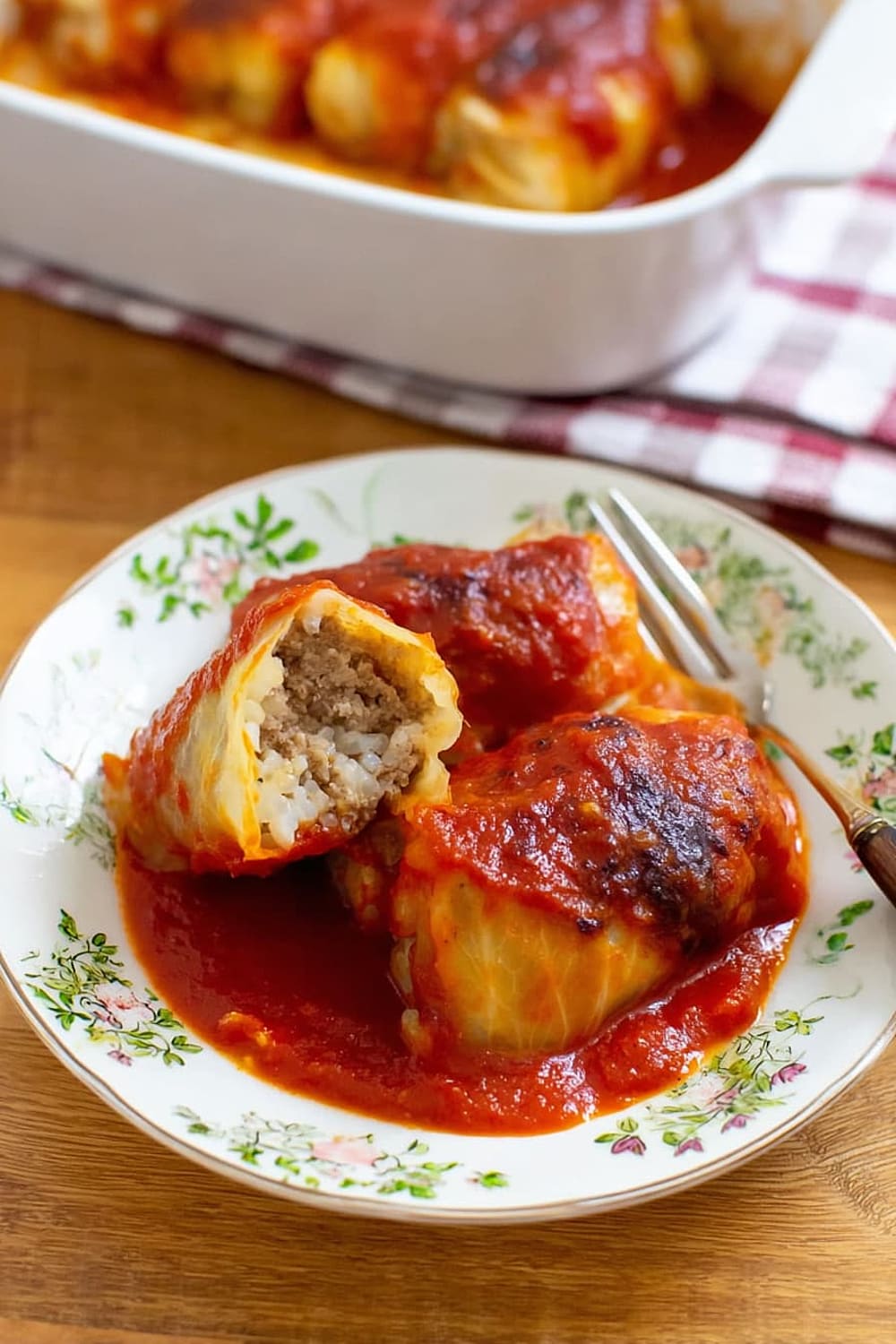
Make It Diabetes-Friendly
Carb Reduction Strategies:
- Rice Modification – Replace half the rice with cauliflower rice that’s been sautéed until moisture evaporates, reducing carbs by approximately 20-25 grams per serving
- Portion Control – Serve 2 medium rolls instead of 3 and pair with a large green salad dressed with olive oil and vinegar
- Vegetable Boost – Add finely diced zucchini or bell peppers to the meat mixture to increase volume without significantly increasing carbs
Smart Serving Suggestions:
- Pair with Protein – Serve alongside Greek yogurt or a small portion of cottage cheese to slow carbohydrate absorption
- Timing Strategy – Enjoy as part of a balanced meal with non-starchy vegetables like steamed broccoli or green beans
- Sauce Modification – Use the tomato sauce sparingly or thin it with additional low-sodium broth to reduce concentrated sugars
Blood Sugar Management:
- Estimated carbs per serving – Approximately 35-40 grams with traditional recipe, 25-30 grams with cauliflower rice substitution
- Fiber content – 6-8 grams per serving helps slow sugar absorption
- Glycemic impact – The protein and fat content help moderate blood sugar response when eaten as part of complete meal
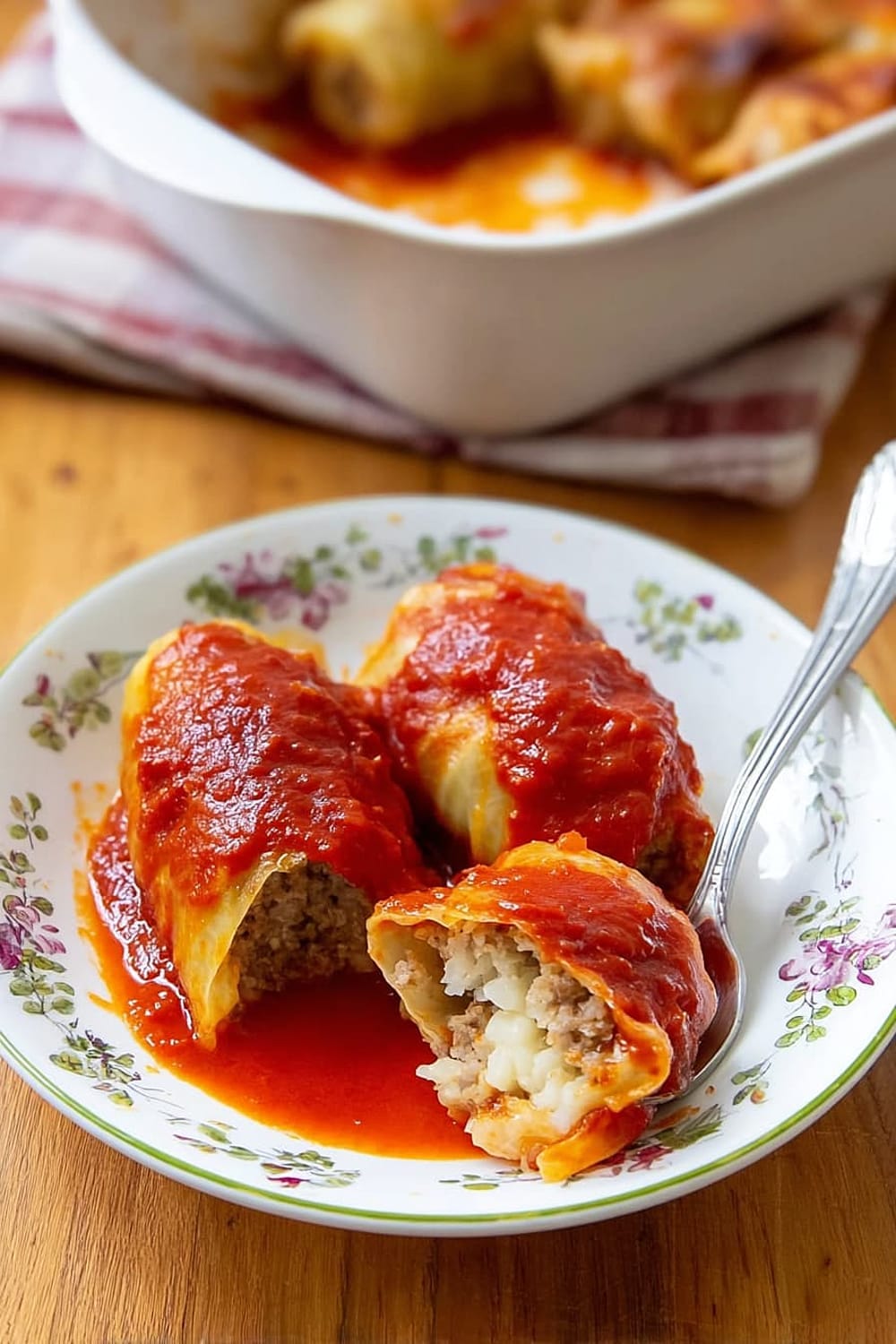
Perfect Pairing Suggestions
Beverage Pairings
A medium-bodied red wine like Merlot or Chianti complements the rich tomato sauce and hearty meat filling beautifully. For beer lovers, a Czech Pilsner or German Märzen provides the perfect crisp contrast to the savory richness. Non-alcoholic options include sparkling water with lemon, unsweetened iced tea, or traditional Polish kompot made from dried fruits.
Side Dish Recommendations
Creamy mashed potatoes or buttered egg noodles are classic accompaniments that soak up the delicious tomato sauce. For lighter options, serve with roasted root vegetables like carrots and parsnips, or a crisp cucumber salad dressed with dill and vinegar to cut through the richness. Sauerkraut provides an authentic Polish touch and aids digestion of the hearty meal.
Complete Meal Ideas
Start with a simple beet and goat cheese salad or Polish cucumber soup as an appetizer. The golumpki serves as a perfect main course for Sunday family dinners or holiday gatherings. Finish with traditional Polish apple cake or fresh fruit to cleanse the palate. This meal works beautifully for meal prep – the flavors actually improve after a day in the refrigerator.
Seasonal Serving Suggestions
These stuffed cabbage rolls shine during fall and winter months when hearty, warming foods are most appreciated. Serve at Thanksgiving as an alternative to traditional sides, or make them the centerpiece of Christmas Eve dinner following Polish tradition. The recipe scales beautifully for entertaining large groups during holiday celebrations.
Pro Tips and Troubleshooting
Professional Techniques
Blanch cabbage leaves gradually – don’t rush this step as properly blanched leaves are the key to successful rolling. The leaves should be pliable but not mushy; they’ll continue cooking in the oven. Chill the meat mixture for 30 minutes before rolling – this makes it easier to handle and helps the rolls hold their shape better during cooking.
Common Mistakes and Solutions
Overstuffing the rolls leads to bursting during cooking – use 1½-2½ tablespoons of filling maximum per leaf. Underseasoning the filling is another pitfall – the mixture should taste slightly oversalted before rolling since the cabbage and rice will absorb some seasoning. Skipping the leaf-lining step in your baking dish can cause sticking and make serving difficult.
Storage and Reheating
Refrigerate cooked golumpki for up to 4 days in the original sauce – they actually taste better the next day as flavors meld. Freeze for up to 3 months in freezer-safe containers with sauce. Reheat gently in a 300°F (150°C) oven covered with foil, or microwave individual portions with a splash of water to prevent drying.
Make-Ahead Strategy
Assemble the rolls completely up to 24 hours ahead and refrigerate before baking – add 10 extra minutes to cooking time if baking from cold. The tomato sauce can be made 2-3 days ahead and actually improves in flavor. Blanched cabbage leaves can be prepared a day ahead and stored in the refrigerator between damp paper towels.
This authentic Polish golumpki recipe brings generations of comfort food tradition right to your dinner table, creating those memorable meals that become family favorites for years to come.